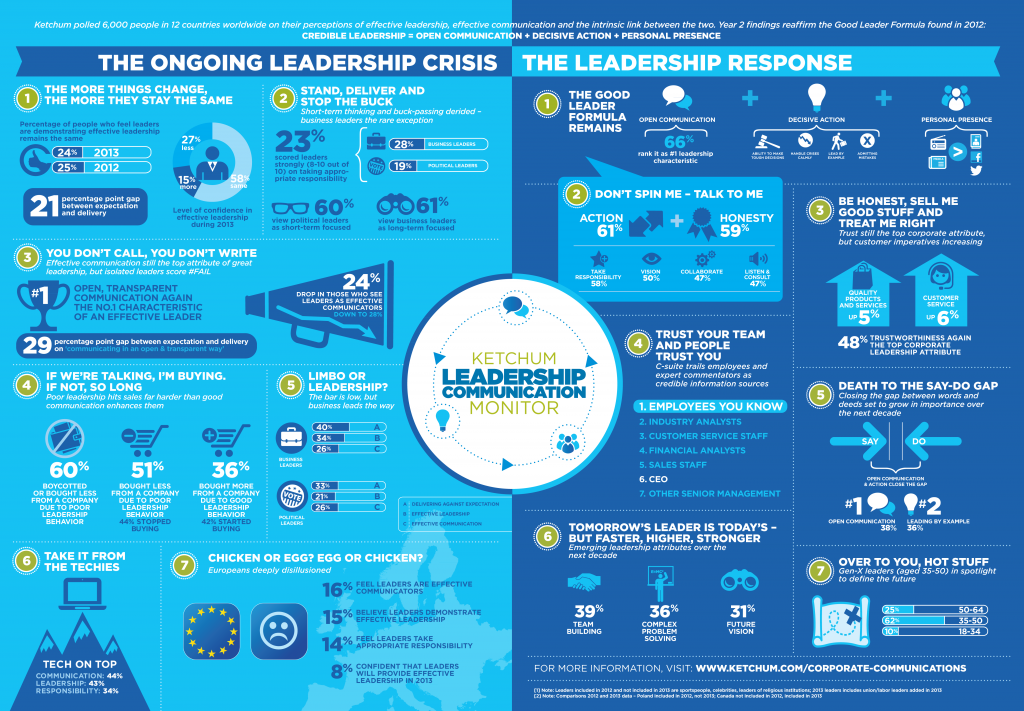In March 2012, Ketchum was pleased to publish the findings of the inaugural Ketchum Leadership Communication (KLCM) study, revealing not only on an unambiguous crisis of confidence in leaders and how they are communicating, but also on a clear blueprint that leaders and their advisors can follow in rebuilding confidence. We are now excited to share the findings of the 2013 Leadership Communication Monitor with you.
As economic and political flux continue – with uncertainty now the new normal and leaders of all kinds remaining under intense, unbroken scrutiny – the findings of this year’s KLCM study are every bit as timely and fascinating.
So what did we find in the 2013 study, this time polling an expanded group of 6,000 consumers across 12 countries on five continents?
Well on one level, plus ça change was a clear theme – the more things change, the more they stay the same – with the crisis of leadership communication rolling on and generating very real commercial consequences for those who are getting leadership wrong.
To unpack this a little, here were some standout themes that, between them, underline the extent of the ongoing problem:
- You don’t call, you don’t write: The world’s crisis of leadership communication continues, with just 24% of people around the world believing leaders overall are providing effective leadership. And with open communication taking the #1 spot for the second year in a row as the most important attribute of effective leaders, the 24% fall in leaders’ communication performance gives real pause for thought.
- Stand, deliver and stop passing the buck: Business leaders come out top on accountability and long-term thinking, with politicians bottom on both. Although the business community’s superior performance is very relative (only 34% rate business chiefs as effective leaders), the world of politics may have something to learn from the business community.
- If you’re talking, I’m buying – if not, so long: Poor leadership directly hits sales and in 2012, 60% of people boycotted or bought less from a company due to poor leadership behavior. Negative leadership perceptions also create a far greater drain on sales than positive perceptions enhance them.
- Take if from the techies: On every measure – leadership, communication and accountability – the technology sector leads the way, enjoying a 14 point gap over its nearest rivals on leadership prowess and providing an interesting model for others.
- Chicken or egg? Egg or chicken?: Europe’s woes are very much reflected in poor views of its leaders. Only 8% of Europeans polled are more confident that leaders will be effective in 2013, just 16% believe leaders are effective communicators and only 14% credit European leaders for taking appropriate responsibility when they fall short of expectations.
And as with last year, we were determined to help identify the cure as well as diagnose the underlying illness. A few tasters on that front:
- The leadership formula isn’t changing: Open communication + decisive action + personal presence continues to be the magic formula for today’s credible leader – and tomorrow’s. Open communication is again the #1 leadership characteristic (66% viewed it as very important) and honesty about the challenge ahead is the top expectation of leaders to restore confidence. And yet, action is every bit as critical, with leading by example, admitting mistakes, handling crises calmly and making tough decisions all in the top-5. If the say-do gap wasn’t dead before, it is now.
- Be honest, sell me good stuff, treat me right: Trustworthiness is still the top corporate leadership attribute, but the importance of caring for and serving customers with the right products has risen sharply, with quality products and services up 5 points to take joint first place and customer service up 6 points to #3.
- Tomorrow’s leader is today’s, but faster, higher stronger: Building and inspiring teams who together will create the future, turning complex problems into opportunities and discerning a clear future through the fog of today will be the mark of tomorrow’s leader.
- Trust your team and people trust you: Employees outrank the CEO as credible corporate ambassadors, with CEOs coming a lowly 6th in the list of credible sources of information on a company. By contrast, employees who people know are the most plausible ambassadors, making effective employee engagement more critical than ever.
- Gen-X marks the spot: An overwhelming 62% of people are looking beyond the Baby Boomers to leaders aged 35-50 to take over and define the future (vs. just 10% voted for 18-34 year-olds and 25% for 60-64 year-olds), highlighting the very different challenges for executive visibility programs involving different generations of leaders.
As we talk with clients about the implications of this year’s data, we’ll continue to blog here on what this means too for our profession. What is immediately clear is that the opportunities and – crucially – the responsibilities for us as professional communicators are more marked than ever.
Click here to download the full Leadership Communication Monitor report.



